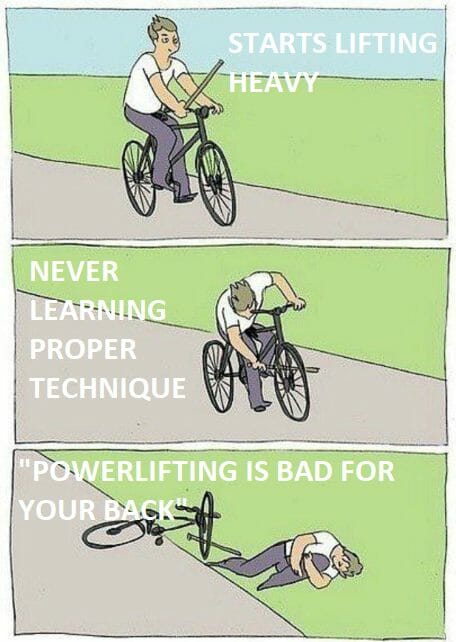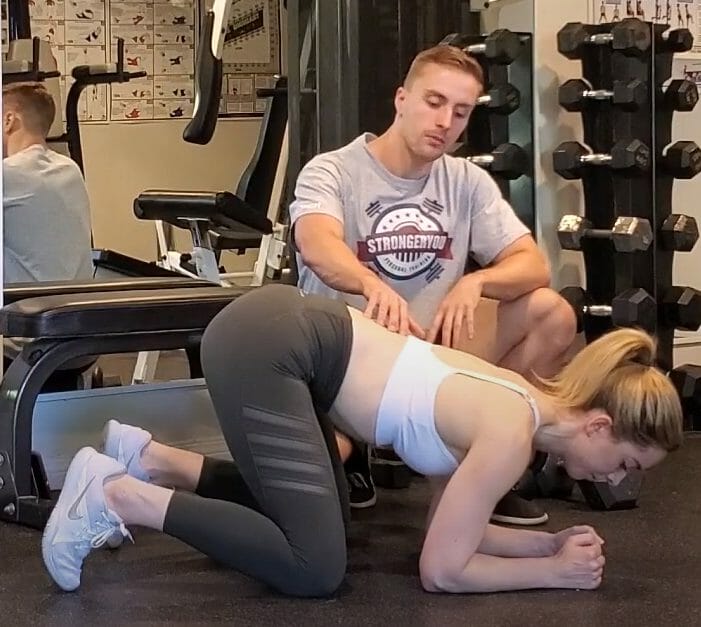Spend enough time in a gym and you’ll hear somebody say (maybe even an old timer who used to “deadlift 700 back in the day”) that powerlifting is bad for your back. While this may have some shreds of truth, I would venture to say most people who accept this as a blanket statement never really learned how to do it properly, got hurt, and called it bad. While people would say you are crazy for driving a race car without learning how to use the brakes properly, missing fundamental principles in the squat can often go unnoticed.
Today’s article is aimed towards two things:
- Outlining potential reasons for your back hurting in the first place, and;
- Cleaning up your squat by establishing good mechanics FOR YOU based on your body proportions and mobility.

Why Your Back Might Hurt
Some common points I will see addressed with dealing with back pain in a squat include a lack of mobility in the hips, knees, shoulders, thoracic spine, or ankles, as well as lifters trying to emulate another lifter’s “ideal form” without considering their own proportions.
The above points are certainly worth addressing, but without properly stabilizing the spine (read more about how to do this in your squat here), they don’t really matter. Ideally in the squat we want to create sufficient intra-abdominal pressure (IAP) in a 360 degree fashion, meaning your front, sides, and back should all be evenly tight. This ensures that the spine is loaded in a compressive manner (where it is very strong) and with minimal shear forces. Ensuring optimum spinal stability is the first point I go over with any lifter I work with as the benefits are so huge, that it often reduces how much work we have to do on “mobility restrictions” or other form problems in the squat. Without proper spinal stabilization, you can’t expect anything else to work properly.
Individualizing Squat Mechanics for Your Body
Before we look at how to find your best form, let’s take a look at some constants that are generally accepted as “good form” on both the high and low bar back squat.
- Bar remains over midfoot
- Spine remains relatively neutral throughout the lift (by maintaining good IAP)
- Feet evenly weighted to keep load over midfoot
- A relatively vertical and straight bar path.
Once we’ve checked the above boxes, we can experiment with different amounts of knee bend, torso angles, and other elements that are lifter-specific.
The most important factors to consider when looking at a theoretical “best form” for a lifter are maximum joint mobility (particularly in the hips, knees, and ankles), and body proportions.
The simplest way to test joint mobility for a squat is to use a rockback test. This allows you to find a comfortable knee/foot position to use for the fullest range of motion possible in the squat.

After we’ve addressed mobility, it’s time to cover limb lengths. Within the scope of a squat, the most important ratio is torso:femur lengths. Relatively speaking, If you have longer femurs, you will need better ankle mobility in order to remain upright in the squat, or you will need to accept more forwards lean than someone with shorter femurs would, in order to comply with the “good form” points we covered earlier.
Joint mobility and limb lengths are super important in understanding the theory behind your squat, but in application, we need to be able to stabilize those ranges of motion/movements against external forces (weight on the bar and gravity, for the most part). Without stability, you can’t produce optimal strength. Take a look at the Japanese Stick Training video below
In practice, your best squat form is the one where you are most stable because that will allow for the best expression of strength as well as minimize excessive/suboptimal amounts of movement at specific joints. By creating a strong platform to lift from, you can distribute the load more equitably throughout the system.
Making Use Of this information
Now that we’ve established a baseline of unloaded movement that allows you to create optimal positioning, adding weight is simple. The goal of implementing this potential change in form is to keep thresholds in mind and work within your limitations. If you have back pain to the point where it stops you from squatting effectively, you’ll probably cap your training weights and exercise variations at or slightly below your technique threshold.
On the other hand, if you’re generally pain free but occasionally get some tightness in your back, you can be less conservative with your loading strategy and keep your normal program going, but work technique changes into your warmup. With conscious effort, this technique will carry over into your working sets over time and you’ll end up more efficient and theoretically with less back issues.
For a more in depth dive into squatting mechanics and a sample progression program, give this article on implementing PRI and DNS concepts into your squat a read.
Hopefully you find this information useful and it helps you with your training by allowing you to address the deficits in your bracing strategy as well as making your form work for you instead of having to fight it all the time. It certainly takes some conscious practice and smart powerlifting programming, but with proper attention to detail, you can resolve many of the issues you get in the squat.
PS – Here’s 3 ways I can help you get stronger:
3. Apply to join my “Momentum Program” and become a case study. We’ll work with you 1-on-1 (in-person or online, depending on location) to consistently increase your PRs.
It takes less than 60 seconds to apply HERE in order to find out more information and see if you’d be a good fit.